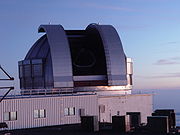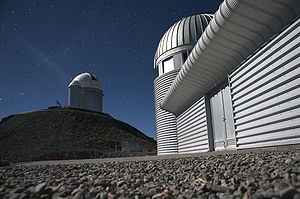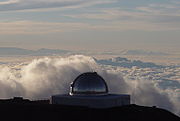
Infrared Telescope Facility
Encyclopedia
The NASA Infrared Telescope Facility (NASA IRTF) is a 3 metres (9.8 ft) telescope
optimized for use in infrared astronomy
and located at the Mauna Kea Observatory
in Hawai'i. It was first built to support the Voyager
missions and is now the USA
national facility for infrared astronomy, providing continued support to planetary, solar neighborhood, and deep space applications. The IRTF is operated by the University of Hawaii under a cooperative agreement with NASA. According to the IRTF's time allocation rules, at least 50% of the observing time is devoted to planetary science
.
The IRTF is mounted on a large English yoke equatorial mount. The mount is very stiff, reducing flexure and allowing for accurate pointing of the telescope. Since the telescope is on an equatorial mount, the telescope can observe targets through the zenith without concern for field rotation. The yoke mount prevents the telescope from pointing north of +69 degrees declination. Since the telescope was primarily intended for planetary science, this restriction was considered to be acceptable. Since the telescope is on a heavy mounting, it is relatively immune from vibration or wind shake.
There have been two other smaller near-infrared telescopes: the 150 cm (59 in) Gornergrat Infrared Telescope
in the Swiss Alps, and the 160 cm (63 in) telescope at the Mont Mégantic Observatory
in Canada.
Telescope
A telescope is an instrument that aids in the observation of remote objects by collecting electromagnetic radiation . The first known practical telescopes were invented in the Netherlands at the beginning of the 1600s , using glass lenses...
optimized for use in infrared astronomy
Infrared astronomy
Infrared astronomy is the branch of astronomy and astrophysics that studies astronomical objects visible in infrared radiation. The wavelength of infrared light ranges from 0.75 to 300 micrometers...
and located at the Mauna Kea Observatory
Mauna Kea Observatory
The Observatories at Mauna Kea, , are an independent collection of astronomical research facilities located on the summit of Mauna Kea on the Big Island of Hawai'i, USA. The facilities are located in a special land use zone known as the "Astronomy Precinct," which is located in the Mauna Kea...
in Hawai'i. It was first built to support the Voyager
Voyager program
The Voyager program is a U.S program that launched two unmanned space missions, scientific probes Voyager 1 and Voyager 2. They were launched in 1977 to take advantage of a favorable planetary alignment of the late 1970s...
missions and is now the USA
United States
The United States of America is a federal constitutional republic comprising fifty states and a federal district...
national facility for infrared astronomy, providing continued support to planetary, solar neighborhood, and deep space applications. The IRTF is operated by the University of Hawaii under a cooperative agreement with NASA. According to the IRTF's time allocation rules, at least 50% of the observing time is devoted to planetary science
Planetary science
Planetary science is the scientific study of planets , moons, and planetary systems, in particular those of the Solar System and the processes that form them. It studies objects ranging in size from micrometeoroids to gas giants, aiming to determine their composition, dynamics, formation,...
.
Telescope
The IRTF is a 3.0 m (118" effective aperture) classical Cassegrain telescope. The Cassegrain focus f/ratio is f/38 and the primary mirror f/ratio is 2.5. Several aspects of the design of IRTF are optimized for IR observations. The secondary mirror is undersized to prevent the instrument from seeing the thermal emission from the telescope structure around the primary mirror. The primary mirror itself is 126" in diameter, but only the center 118" is used. A small mirror in the center of the secondary mirror prevents the instrument from seeing its own thermal emission. The f/ratio is long to have a small secondary mirror, again to minimize the telescope's thermal emission. The mirror coatings are chosen to have minimal thermal emission. The emissivity of the telescope is usually below 4%. The secondary mirror is mounted on a chopping mechanism to rapidly switch the pointing of the telescope from target to sky at up to 4 Hz.The IRTF is mounted on a large English yoke equatorial mount. The mount is very stiff, reducing flexure and allowing for accurate pointing of the telescope. Since the telescope is on an equatorial mount, the telescope can observe targets through the zenith without concern for field rotation. The yoke mount prevents the telescope from pointing north of +69 degrees declination. Since the telescope was primarily intended for planetary science, this restriction was considered to be acceptable. Since the telescope is on a heavy mounting, it is relatively immune from vibration or wind shake.
Instrumentation
The IRTF hosts 4 facility instruments: SpeX, NSFCam2, CSHELL, and MIRSI. MORIS is being currently being tested. IRTF also hosts a number of visiting instruments.SpeX
SpeX is a medium-resolution 0.8-5.4 micron spectrograph built at the Institute for Astronomy (IfA), for the NASA Infrared Telescope Facility (IRTF) on Mauna Kea. The primary scientific driver of SpeX was to provide maximum simultaneous wavelength coverage at a spectral resolving power which is well-matched to many planetary, stellar and galactic features, and at resolving power which adequately separates sky emission lines and disperses sky continuum. This requirement has resulted in an instrument which provides spectral resolutions of R~1000-2000 across 0.8-2.4 micron, 2.0-4.1 micron, and 2.3-5.5 micron, using prism cross-dispersers (15 arcsec-long slits). Single order long slit (60 arcsec) modes are also availavble. A high throughput prism mode is a provided for 0.8-2.5 micron spectroscopy at R~100 for solid state features and SEDs. A Raytheon Aladdin 3 1024x1024 InSb array is used in the spectrograph. SpeX also contains an infrared slit-viwer/guider covering a 60x60arcsec field-of-view at 0.12arcsec/pixel. A Raytheon Aladdin 2 512x512 InSb array in the infrared slit-viewer. The infrared slit viewer can also be used for imaging or photometry. SpeX is used for a wide array of planetary and astrophysical research programs, and is the most requested instrument on IRTF. SpeX will be taken off of the telescope for about 6 months to upgrade its arrays starting in August 2012.CSHELL
CSHELL is a 1 - 5.5 micron high resolution single-order echelle spectrograph which uses a 256 x 256 pixel InSb detector array. Each pixel is 0.2" on the sky and the spectroscopic dispersion is 100,000 per pixel. Slits from 0.5" to 4.0" provide spectral resolutions of up to 30,000. CSHELL also has an IR imaging mode for source acquisition which covers a 30" x 30" field. An internal CCD with a 1' FOV allows for guiding.MIRSI
MIRSI is a 2.2 to 25 micron thermal infrared imaging camera with grism spectrographic capability. MIRSI was built by Boston University and is now based at the IRTF. It is the only facility instrument that is cooled by liquid Helium, and the only instrument that uses the chopping mode of the secondary mirror. MIRSI has a selection of broad-band and narrow-band filters, as well as a CVF.NSFCam2
NSFCAM2 is a 1-5 micron camera, built at the Institute for Astronomy, (IfA), for the NASA Infrared Telescope Facility (IRTF). The camera uses a 2048x2048 Hawaii 2RG detector array. The image scale is 0.04 arcsec/pixel and the field of view is 82x82 arcsec. It contains two filter wheels. The first is a 28 position wheel containing broad-band and narrow-band filters, and a wire-grid polarizer. The second contains a 1.5-5 micron CVF and grisms. for low-resolution spectroscopy. A third wheel, located at the F/38 telescope focal plane inside the camera, contains grism slits and field lenses. An external wheel containing a waveplate can be used with a polarizer in the CVF wheel for polarimetry. NSFCam2 will be taken off of the telescope in October 2011 to upgrade its array to a higher quality engineering grade Hawaii 2RG array with a new array controller.MORIS
MORIS (MIT Optical Rapid Imaging System) s a high-speed, visible-wavelength camera for use on IRTF using an electron multiplying CCD. MORIS is mounted on the side window of SpeX, and is fed by the internal cold dichroic in SpeX. The design is based on POETS (Portable Occultation, Eclipse, and Transit Systems), which were developed by a collaboration between MIT and Williams College. MORIS is currently being tested on IRTF and its user interface is being converted to the IRTF standard interface.Visiting instruments
IRTF also hosts a number of visitor instruments, usually thermal infrared spectrographs. These have recently included TEXES, EXES, BASS, and HIPWAC.Future instruments
The IRTF staff are currently developing iShell. This will be a high resolution (R=80,000) 1-5 micron cross dispersed spectrograph that will replace CSHELL. By using a larger array and a cross disperser, iShell will have much larger wavelength coverage per setting than CSHELL. Like SpeX, iShell will also have an infrared slit viewing guider and pupil imager. iShell will use an immersion grating to achieve a high dispersion with a relatively small grating, which in turn allows the optics and the whole instrument to be much smaller than if it used a conventional grating.Remote observing
The majority of IRTF users prefer to use IRTF remotely. Observers can use IRTF from any location with a high speed internet connection, such as their office or home, anywhere around the world. The observer controls the instrument via a VNC session, just as they would at the summit, and communicates with the telescope operator via phone, Polycom, or Skype. The observer calls in and logs in for their time allocation. Remote observing has several advantages. Remote observing spares the observer from the time and cost of traveling from their home institution to Hawaii. In the past, when observers used the telescope from the summit, the telescope was scheduled in full nights. With remote observing, observers only need to submit a request for the amount of time they need, when they need it, instead of asking for whole nights. Since the observers do not travel to Hawaii, they can request to use the telescope more frequently. This has enabled the IRTF to support many programs where frequent observations of targets are necessary, such as weekly monitoring of the variability of a star. Remote observing has also allowed the IRTF to support target of opportunity (ToO) programs. These are programs of high scientific merit but where the timing of the observation cannot be predicted at the time that telescope proposals are due. Examples include supernovae, which explode unexpectedly, or near-earth asteroids that may be discovered shortly before their closest approach to the Earth. Although the observers are usually remote, the telescope operator is at the summit to ensure the safety of the facility, assist the observer, and trouble shoot problems that may arise during the night.Comparison to contemporaries
Dedicated infrared telescopes require a high and dry location, special instrumentation, and similar high-quality mirrors and optics as for visible wavelength observations. Other large optical infrared and near-infrared telescopes circa 1980:| # | Name(s) / Observatory |
Image | Aperture | Spectrum | Altitude | First Light |
|---|---|---|---|---|---|---|
| 1 | United Kingdom Infrared Telescope United Kingdom Infrared Telescope UKIRT, the United Kingdom Infra-Red Telescope, is a 3.8 metre infrared reflecting telescope, the largest dedicated infrared telescope in the world. It is operated by the Joint Astronomy Centre in Hilo and located on Mauna Kea, Hawai'i as part of Mauna Kea Observatory... Joint Astronomy Centre Joint Astronomy Centre The Joint Astronomy Centre operates British, Canadian and Dutch telescopes at Mauna Kea Observatory, and provides support for other telescopes and public outreach activities... |
 |
380 cm (150 in) | Infrared | 4205 m (13,796 ft) | 1979 |
| 2 | ESO 3.6 m Telescope ESO European Southern Observatory The European Southern Observatory is an intergovernmental research organisation for astronomy, supported by fifteen countries... La Silla Obs. La Silla Observatory La Silla Observatory is an astronomical observatory in Chile with three telescopes built and operated by the European Southern Observatory organisation, and several others are partly maintained by ESO... |
 |
357 cm (141 in) | Visible Infrared | 2400 m (7,874 ft) | 1977 |
| 3 | NASA Infrared Telescope Facility Mauna Kea Observatory |
 |
300 cm (118 in) | Infrared | 4205 m (13,796 ft) | 1979 |
There have been two other smaller near-infrared telescopes: the 150 cm (59 in) Gornergrat Infrared Telescope
Gornergrat Infrared Telescope
The Telescopio InfraRosso del Gornergrat is located on the northern tower of the Kulm Hotel at Gornergrat near Zermatt, Switzerland. It was a Cassegrain telescope with a tip-tilt correcting secondary and optimized for infrared observations, but was decommissioned in March 2005...
in the Swiss Alps, and the 160 cm (63 in) telescope at the Mont Mégantic Observatory
Mont Mégantic Observatory
The Observatoire du Mont-Mégantic is an astronomical observatory owned and operated jointly by the Université de Montréal, the Université Laval and the McGill University...
in Canada.

